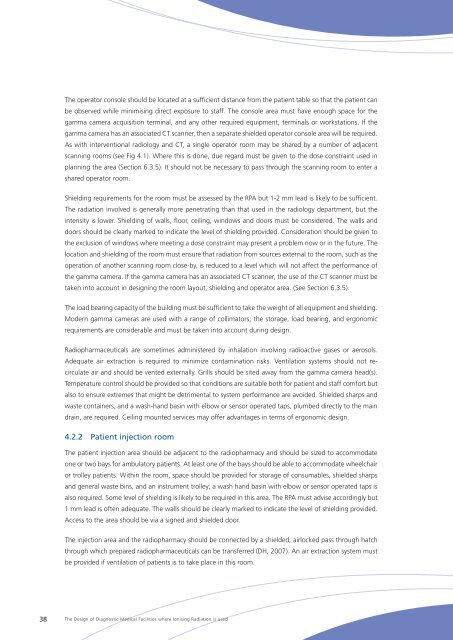The Design of Diagnostic Medical Facilities where ... - ResearchGate
The Design of Diagnostic Medical Facilities where ... - ResearchGate
The Design of Diagnostic Medical Facilities where ... - ResearchGate
Create successful ePaper yourself
Turn your PDF publications into a flip-book with our unique Google optimized e-Paper software.
<strong>The</strong> operator console should be located at a sufficient distance from the patient table so that the patient can<br />
be observed while minimising direct exposure to staff. <strong>The</strong> console area must have enough space for the<br />
gamma camera acquisition terminal, and any other required equipment, terminals or workstations. If the<br />
gamma camera has an associated CT scanner, then a separate shielded operator console area will be required.<br />
As with interventional radiology and CT, a single operator room may be shared by a number <strong>of</strong> adjacent<br />
scanning rooms (see Fig 4.1). Where this is done, due regard must be given to the dose constraint used in<br />
planning the area (Section 6.3.5). It should not be necessary to pass through the scanning room to enter a<br />
shared operator room.<br />
Shielding requirements for the room must be assessed by the RPA but 1-2 mm lead is likely to be sufficient.<br />
<strong>The</strong> radiation involved is generally more penetrating than that used in the radiology department, but the<br />
intensity is lower. Shielding <strong>of</strong> walls, floor, ceiling, windows and doors must be considered. <strong>The</strong> walls and<br />
doors should be clearly marked to indicate the level <strong>of</strong> shielding provided. Consideration should be given to<br />
the exclusion <strong>of</strong> windows <strong>where</strong> meeting a dose constraint may present a problem now or in the future. <strong>The</strong><br />
location and shielding <strong>of</strong> the room must ensure that radiation from sources external to the room, such as the<br />
operation <strong>of</strong> another scanning room close-by, is reduced to a level which will not affect the performance <strong>of</strong><br />
the gamma camera. If the gamma camera has an associated CT scanner, the use <strong>of</strong> the CT scanner must be<br />
taken into account in designing the room layout, shielding and operator area. (See Section 6.3.5).<br />
<strong>The</strong> load bearing capacity <strong>of</strong> the building must be sufficient to take the weight <strong>of</strong> all equipment and shielding.<br />
Modern gamma cameras are used with a range <strong>of</strong> collimators; the storage, load bearing, and ergonomic<br />
requirements are considerable and must be taken into account during design.<br />
Radiopharmaceuticals are sometimes administered by inhalation involving radioactive gases or aerosols.<br />
Adequate air extraction is required to minimize contamination risks. Ventilation systems should not recirculate<br />
air and should be vented externally. Grills should be sited away from the gamma camera head(s).<br />
Temperature control should be provided so that conditions are suitable both for patient and staff comfort but<br />
also to ensure extremes that might be detrimental to system performance are avoided. Shielded sharps and<br />
waste containers, and a wash-hand basin with elbow or sensor operated taps, plumbed directly to the main<br />
drain, are required. Ceiling mounted services may <strong>of</strong>fer advantages in terms <strong>of</strong> ergonomic design.<br />
4.2.2 Patient injection room<br />
<strong>The</strong> patient injection area should be adjacent to the radiopharmacy and should be sized to accommodate<br />
one or two bays for ambulatory patients. At least one <strong>of</strong> the bays should be able to accommodate wheelchair<br />
or trolley patients. Within the room, space should be provided for storage <strong>of</strong> consumables, shielded sharps<br />
and general waste bins, and an instrument trolley; a wash hand basin with elbow or sensor operated taps is<br />
also required. Some level <strong>of</strong> shielding is likely to be required in this area. <strong>The</strong> RPA must advise accordingly but<br />
1 mm lead is <strong>of</strong>ten adequate. <strong>The</strong> walls should be clearly marked to indicate the level <strong>of</strong> shielding provided.<br />
Access to the area should be via a signed and shielded door.<br />
<strong>The</strong> injection area and the radiopharmacy should be connected by a shielded, airlocked pass through hatch<br />
through which prepared radiopharmaceuticals can be transferred (DH, 2007). An air extraction system must<br />
be provided if ventilation <strong>of</strong> patients is to take place in this room.<br />
38<br />
<strong>The</strong> <strong>Design</strong> <strong>of</strong> <strong>Diagnostic</strong> <strong>Medical</strong> <strong>Facilities</strong> <strong>where</strong> Ionising Radiation is used
















